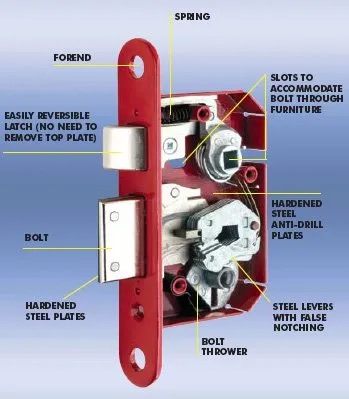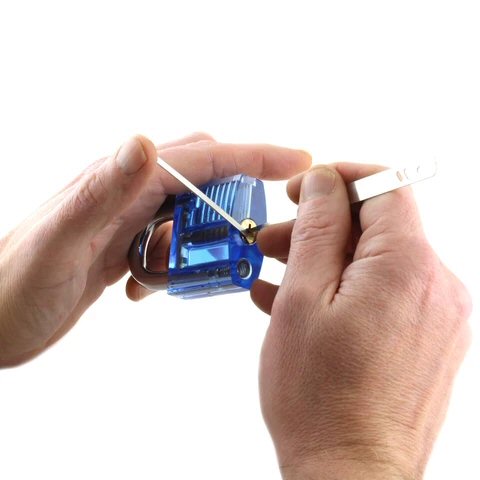How To Pick Locks - The First Five Steps
What you need to start lock picking
1 - What Locks do I Start With?
Before you even think about buying your first lock pick set, you should educate yourself a little bit about what locks you're looking to pick. There's probably more locks out there than you think, and variations of each of those. For example, off the top of my head here's a few...
- Pin-Cylinder (Paracentric, Security pins, Dimple, Sidebars)
- Lever (Curtained and non-curtained)
- Disc Detainer
- Wafer (Single sided, double sided)
- Tubular (4, 7, 8, 10 pin, Different Gauges)
- Combination (Wheeled, push-button, Mechanical, Digital)
- Cut-Away Practice Locks
- Clear practice Locks
- Repinnable Clear and/or Cut-Away Practice Locks
Luckily, people have been picking locks for years - centuries in fact - and it's pretty much considered standard procedure to begin your lock picking journey with basic pin-cylinder locks, the type you will have on your front door, or know from padlocks. The housing may be different but the mechanism is much the same.

A Disc Detainer padlock + Keys. Not a good place to start!
Do not pick locks you have in use. If you break a pick in the lock, or damage it in any way, you'll need to call a locksmith and it's going to cost you a lot of money and hassle. And do not pick anyone else's locks - this could get you in big trouble!
So, a door lock such an an ERA rim-cylinder or a YALE rim-cylinder would be a good place to start, or a cheap EURO-CYLINDER or PADLOCK from your local DIY shop (or online) would be a good place to start. All of these are pin-cylinders, and probably won't have any SECURITY PINS (spool or serrated for instance) or other security features which will cause confusion - and then frustration - for the beginner.
An Era rim-cylinder. A basic pin-cylinder lock.
Alternatively you could get a PRACTICE LOCK. While not being a 'real lock' so to speak, they can assist the beginner because there's no security features that might catch you out. You can also SEE INSIDE THE LOCK, the effect of the key on the pins, and how your pick and how it engages with the pins. Practice locks show you how locks work - and therefore how lock picking works.
If you want to check you have an appropriate lock to learn learning lock picking, feel free to ask us, or we can advise you about something suitable.
2 - What Lock Picks do I Need?
It's a good thing that nearly all lock pickers start with pin-cylinders since most of the beginner lock pick sets - I'd actually say all of them - are for pin-cylinder locks. Most of the practice locks are also pin-cylinders. You could imagine if someone gave you a curtained-mortice lock (a very advanced lock to pick) and you bought a beginner lock pick set - there's no chance those picks will open that lock - and it's worth mentioning - people have tried!

Curtained Mortice Lever Lock - NOT FOR BEGINNERS
You could then spend more money on a more expensive lock pick set and - you guessed it - you still won't get anywhere with that lever lock. But because the lock picking world has established pin-cylinder locks as the locks to start lock picking, it's quite easy to get your first lock pick set. Feel free to contact us if you want to discuss what's available for your budget and requirements, we're always happy to help.
This set HERE or this set HERE are perfect for beginners, or if you want a complete lock picking set, with an illustrated guide, lock picks, and practice locks, you could look at something like THIS SET which is an all-in set with everything you need to start picking locks immediately - image below.

Complete Lock Picking Set For Beginners
3 - What You Need to Know
Two questions I get asked all day, every day are: What does each pick do? And What order do I pick the pins? The first question is something you'll understand through practice and simply finding out what picks work best for you. While all the different picks might look overwhelming at first, they don't actually do different things - they all pick pins. Some are lock rakes, and I'll talk about raking shortly, but while it's worth familiarizing yourself with the names of your new lock picks (there's plenty of information about this online) don't let this concern you too much at this stage.
You will also see some tension wrenches. These are neither picks or rakes, but used to apply tension to the lock while you're picking or raking it. But that's for another blog. You'll soon work out why and how you use tension wrenches as you start actually picking locks. YouTube is a great place to learn about lock picking, I really like THIS CHANNEL as it shows Cross-Sections of locks so you can see what's really happening in the locks., he's also very funny, which is a bonus!
There is a difference between lock picks and lock rakes - this is an easy distinction to make because a lock pick has a shape right on the tip of the pick and a lock rake has a patterns all along the shaft. You will learn about raking fairly quickly as it's widely considered a beginners technique. And although Raking locks can be quite advanced, you'll probably open your first lock or locks using the raking technique as it's easy to learn and a great way to help you get to know your way around a pin cylinder lock.

The other technique, the one that doesn't use rakes and which is considered 'lock picking proper' is Single Pin Picking (SPP) which speaks for itself, each pin is picked individually, whereas lock raking is where you engage all (or multiple) pins together. HERE'S A BLOG ABOUT RAKING you could have a look at to help understand the difference, but Single Pin Picking or SPP is really the technique you'll be learning.
Not only will you soon discover what picks and rakes work well for you, but what picks work best for different pin types, different tolerances, different heights of pins - all sorts of variables. In short, the variables of the lock in hand (for instance the size and shape of the keyway, the pin heights or 'biting') will dictate what pick or picks to use. So don't worry to much about what each pick is for or what it's called now, just start lock picking and learning and let that information come to you with time. It's fun - don't stress - we all started at the beginning!
The second question, 'What order do I pick the pins?', leads us to one of the most important aspects about lock picking which we call the binding order. This is a principle that carries on to most of the other forms of lock picking, such as wafer locks, tubular locks, lever locks, disc detainer locks, etc. You don't just pick the pins in a random order, in fact the lock dictates the order in which you pick the pins and it's called The Binding Pin Principle. You can read all about the binding pin principle HERE.

Figure C 'Pin Not Binding' - Figure D 'Pin Binding'
In short, when you apply tension to the lock with a tension wrench, you create a very small ledge in the lock called the 'shearline', but one pin BINDS, meaning just one pin becomes trapped between the core (or 'plug') of the lock and the housing. Since this pin is binding, it provides resistance when you try to push it with a lock pick. The other pins that are not binding and therefore are not 'trapped' between the core and the housing, you can identify the binding pin by trying different pins and feeling for the one that's providing the most resistance. That pin is the binding pin and that's the first pin you pick. You'll feel the plug move very slightly, and another pin will bind. You then have to identify that pin and pick that. Keep doing that until there's only one pin left, pick that and bingo! The lock opens.
4 - What You Need to Do
Get some locks! Get a good quality ILLUSTRATED GUIDE to Single Pin Picking. Get some locks. It's important you have a variety of locks in case there's a damaged pin or other anomaly in your only lock that will prevent you from successfully picking it and drive you crazy.
A CUT-AWAY PRACTICE LOCK is a great idea and probably the best place to start, or a CLEAR PRACTICE LOCK. You can also get REPINNABLE LOCKS which mean you can keep changing the pins, which will change the binding order, so you have many locks in one.

Clear Practice Lock with different 'biting' each end (2 in 1)
Get some lock picks! I've linked you above to some great starter sets that will not need replacing as you develop as they are professional quality lock picks. You'll only need to add to your lock pick set when you're looking at higher security locks or other techniques. You'll know what the solution is when you identify the problem.
Educate yourself. We've spoken about getting a guide, and reading some BLOGS, but there's LOADS of information on the internet which is worth reading. The more information you have, the more knowledge you'll develop and the better you'll become at picking locks.
5 - Everything Else
So you have your picks, you've got your locks, you have a guide and have watched far too many YouTube videos. You're ready to go. There's a few things I'd advise. There's some very good lock picking communities on Facebook and other social media sites. You can also follow YouTubers on Twitter to keep you engaged with what they're doing. Social media isn't for everyone but being part of a lock picking community will certainly help you develop faster and you can ask real-time questions and get many different people's input. I would certainly recommend joining some lock picking forums.
Lock Picking Legend YouTube Channel showing Spool Pin in Cross-Section
And don't be afraid or embarrassed to ask questions. We all started at the beginning. We all made mistakes, we learn from mistakes and to be honest, the lock picking community are a very friendly bunch, they rarely tolerate idiots or anyone putting down beginners. You can also ask us, we're more than happy to provide all our customers with lock picking help and assistance whenever you need it.
You're about to start an amazing journey and learn the art of lock picking - enjoy yourself!
Chris Dangerfield
Please SHARE this blog.


